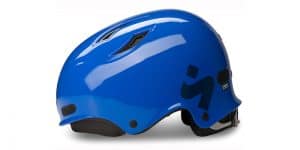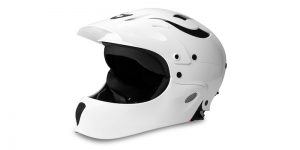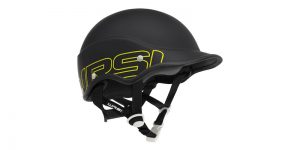So you’ve decided you need to get a helmet for kayaking. That’s a great decision, but what type should you go for and how do you know it’s any good? There are hundreds of different options on the market with different features and it can all get a little confusing knowing what you actually need.
To help you make sense of it all, we’ve written a kayak helmet buying guide to break down the important features you need to look for. We’ve also reviewed some of what we think are the best kayak helmets on the market to help you narrow down your search. Let’s jump in.
Quick Answer: The Best Helmets for Kayaking

The Best Rated Kayak Helmets: Our Reviews
We know that the top things that customers look for in a new helmet are price, durability, comfort, and overall level of protection the helmet will provide. After a lot of research, we’ve compiled a list of the top ten kayak helmets on the market.
#1. The Sweet Protection Strutter Paddle Helmet

In the top spot is Sweet Protection’s Strutter Paddle Helmet. The outer shell is made of a combination of fibreglass and carbon fibre, making it sturdy while still having some elasticity for a more comfortable fit. The adjustable Occigrip band keeps the helmet in place without being too tight.
The lining is made of an EVA plastic to provide shock absorption to help keep you safe. The high-memory material will shape to the contours of your head, allowing for a better, more comfortable fit.
This is the best helmet on the market in terms of protection, comfort, and durability.
#2. The Sweet Protection Wanderer Kayak Helmet

Next is Sweet Protection’s Wanderer Kayak Helmet. This helmet features a shell and jaw guard made of ABS thermoplastic, which increases the helmet’s resistance to impact. The EPP liner provides high-level shock absorption and features a “CoolMax” material which helps ease the discomfort of wearing a helmet on a hot summer day.
Like Sweet Protection’s Strutter Paddle Helmet, the Wanderer features an adjustable Occigrip band for a more comfortable fit.
#3. The WRSI Current Kayak Helmet
- Multi-Impact Shell: Combined with an EVA foam liner and a polyurethane sub-shell to effectively dissipate impacts
- Interconnect Retention System: Securely holds the helmet in place under hydraulic forces, as the force of the water pushes the...
- Adjustable O-Brace Harness: Conforms to the back of the head to help keep the helmet safely positioned
Next up is WRSI’s Current Kayak Helmet. This next helmet has a shell made of ABS plastic with a polyurethane sub-shell for extra protection. The WRSI Current was designed to withstand multiple impacts, so you can rest easy knowing that your helmet won’t break if you have an accident while kayaking.
Like the Strutter Paddle Helmet, the Current has an EVA plastic foam-like lining to absorb shock and make the helmet more comfortable for the wearer. The helmet features a three-hole ventilation system to allow for better airflow and temperature control. The ventilation holes also work as a drainage system so water won’t get trapped in your helmet if you happen to capsize.
#4. The Sweet Protection Rocker Full Face Kayak Helmet

Sweet Protection’s Rocker Full-Face Kayak Helmet is a heavy-duty piece of equipment. As the only full-face helmet on our last, it has many extra features for optimal protection.
The Rocker has two outer shells: an upper body made of Thermoplastic Laminated Carbonfiber (TLC) and a lower shell made of ABS Thermoplastic.
The carbonfiber shell allows for the optimal balance between durability and elasticity, making the helmet both safe and comfortable. Simultaneously, the ABS thermoplastic gives the helmet a higher level of impact resistance than its competitors. The removable visor helps protect your eyes from the sun and water.
The Rocker features an expanded polypropylene (EPP) foam lining for better shock absorption and the same CoolMax liner featured in Sweet Protection’s Wander helmet, which allows for better temperature control than a standard helmet.
The two-way adjustable Occigrip that is a signature feature in Sweet Protection helmets allows for a great fit while still being comfortable for long-term wear.
#5. The WRSI Trident Composite Helmet

Rounding out our Top Five is WRSI’s Trident Composite Helmet. The Trident has a dual shell system, an outer shell composed of carbon-composite, and a polyurethane sub-shell. The double-shell allows for greater protection and ensures that both you and your helmet are safe from impact.
The helmet’s lining is made of an EVA foam to allow for greater comfort and shock absorption levels. The lining is also removable, so you can easily take it out to air dry or clean.
The Composite also has an interconnected harness system that conforms to the shape of your head and auto-adjusts to keep the helmet firmly in place even as water is pushing it.
#6. The NRS Havoc Livery Kayak Helmet

If you’re on a budget, the NRS Havoc Livery Kayak Helmet is a solid choice. The helmet outer shell is made of ABS material, making it sturdy and durable.
This model’s key feature is the unique adjustable DialFit system that allows you to adjust the helmet to fit your head better, making it a one-size-fits-all device.
The lining includes soft padding at key contact areas for shock absorption where it is most needed. While having padded points rather than a fully padded lining means there is less shock absorption overall, it does allow for a more breathable design.
The Havoc helmet also features six ventilation holes to allow for the flow of both air and water.
#7. The BERN Summer Watts EPS Helmet
- Durable ABS Thinshell EPS: Long lasting Hard Shell protection with great ventilation.
- All Season compatible with optional Winter Sports conversion kit for year round value & usability.
- Compass Fit dial adjustment system
Another more affordable option is the BERN Summer Watts kayaking helmet. Modelled after the modern baseball-style helmets, the Summer Watts was designed with style in mind. The shell is made of an ABS material, with a rigid foam lining made of EPS, making it a solid choice for protection from impact.
The Summer Watts also has an adjustable fit system, allowing you to customize the helmet to the shape and size of your head. You also have the option of adding or removing the warm and cold weather linings, making the helmet suitable for both summer and winter sports. This allows for greater versatility if that is a quality you look for in a helmet.
The helmet’s ventilation system is designed to pull air through the vents in the front of the helmet and push air out through the vents in the back. This allows for better airflow and temperature control.
#8. Pro-Tec Ace Water Helmet
- X-Large size professional quality helmet for water action sports; fits head 23. 6-24. 4 inches (60-62cm)
- High-impact ABS shell and waterproof dual-density EVA liner protect against hard, fast falls
- Removable cupping ear guards with water Channels and padding prevent ear drum damage
Next up, we have the Pro-Tec Ace Water Helmet. This helmet has a high-density shell made of ABS for maximum protection. It also features a thick waterproof EVA liner to help absorb shock without getting weighed down from soaking in water.
The interior is designed to fully support and protect your head, with an adjustable system made to fit every head. With a groundbreaking 15 vents to promote better airflow, you can expect that it will keep you cool in the sun.
The helmet also has a unique strap in the back to attach a light, goggles, or a camera to capture all of your kayaking adventures,
#9. The NP Surf Water Sports Helmet
- CE approved EN 1391
- Ultra light non-water absorbent construction
- Impact resistant ABS outer shell and impact absorption soft EVA inner lining
If you’re looking for a lightweight helmet, the NP Surf Water Sports helmet is a great, affordable option for you. This helmet has an ABS outer shell to resist impact and a soft, comfortable EVA foam lining to absorb impact.
It’s also water-resistant, making it an excellent choice for those looking for a helmet for casual use in water sports.
#10. Tontron Kayaking Canoeing Surf Helmet
- ABS outer shell for impact protection and quick dry soft EVA absorption liner.
- Removable ear protection pads and adjustable back of head dial.
- 11 Air-vents system for breathing.
Last, but certainly not least, is the most affordable helmets on our list: the Tontron Adult Kayaking Canoeing Surf Helmet. At a whopping 413 grams, the Tontron helmet is the lightest, making it an excellent choice for those who find the heavy-duty helmets too uncomfortable.
Just like the NP Water Sports helmet; the Tontron has an outer shell made of ABS and a soft EVA foam lining. This helmet also features removable padding to protect the wearer’s ears from harm.
How to Choose a Kayak Helmet: A Buyer’s Guide

Not all kayaking is a flat-water, relaxing, touring experience. Nothing exemplifies this more than whitewater kayaking. It’s about the polar opposite of what coastal and beach cruisers do. Boats are short and nimble, and they’re thrown at the mercy of raging rivers, with whirlpools and torrents of powerful water.
But with all the excitement comes a little danger, too. What makes the water white, you ask? Well, it’s the massive flow of water around rocks. And with so many unseen twists and turns, while paddling the most unstable type of kayak, the danger of getting wet or capsized is extreme. Many would say that’s half the fun.
With so many dangers lurking below the water, you’ve got to be protected. Drowning is a genuine risk, not because capsizes are hard to recover from or the kayak impossible to keep upright. Drowning is dangerous because of the risk of head injuries. If a simple capsize ends with your head impacting a rock and you go unconscious, you aren’t there to recover and get out of the water.
For any type of paddling where there’s a risk of head injury, a helmet is a must-have piece of equipment. It might not be raging whitewater, either. Maybe you’re a tour guide or instructor and wary of novices with errant paddles.
Types of Kayaking Helmets
Helmets come in three basic sizes to suit the level of risk management you require. Generally, the smaller a helmet is, the less it covers, and therefore the less protection it provides.
Half-Cut Helmets
Half-cut helmets are the smallest helmets. They protect the top of your head, but not for your face or ears. They’re best used for easy or moderate whitewater paddling or other recreational trips where there’s a risk of bumps.
While half-cut helmets are certainly lighter and can be more comfortable, they tend to have the worst fits of any helmet type. Since they just sit on top of your head, they rely solely on their harness system to keep them in place.
Full-Cut Helmets
Full-cut helmets are slightly larger, so they provide more protection. Since they are more form-fitted to the shape of your skull, they fit better and are less likely to move around. All of this makes them appropriate when in more moderate whitewater conditions.
As helmets get larger, they cover more of your ears and may impact your ability to hear. Keep this in mind when picking a helmet. If you often paddle with others or need to hear people shouting, it can be challenging with some helmets.
Full-Face Helmets
As their name implies, full-face helmets offer up the most protection by covering pretty much everything above your shoulders. They resemble full motorcycle helmets. Their lower case even protects your jaw.
Not only can full-face helmets impact your ability to hear, but since they cover your mouth, they can keep people from hearing you. They’re also the largest and most bulky style of helmet to wear, so they are generally reserved for the most extreme whitewater conditions.
Helmet Materials and Construction

Helmets are made with various forms of modern plastics that can take some abuse while protecting your delicate noggin. Understanding a little bit about the materials helps ensure you get the helmet your looking for.
Acrylonitrile Butadiene Styrene (ABS)
Acrylonitrile Butadiene Styrene or ABS for short is a thermoplastic that is turned into a liquid and then shaped into the helmet. When it cools, it becomes rigid. It’s a hard, durable plastic shell material that can take impacts but can be dented or cracked with enough force.
Like any plastic, you can find ABS in different thicknesses and weights. Just because a helmet is made of durable ABS doesn’t mean that it is thick enough for the job.
Ethylene-Vinyl Acetate (EVA)
Ethylene-Vinyl Acetate or EVA for short is a closed-cell foam used in many applications where you need something with some give or padding, but you don’t want it to absorb water. The classic examples that nearly everyone is familiar with are those no-skid pads put on paddleboard decks.
In helmets, EVA is used as a lining. It absorbs some shock in case of impact, and it gives you some protection in case the outer shell of your helmet gets damaged. It’s also buoyant, which helps the helmet float. And, of course, it offers a little padding to keep the helmet comfortable.
Expanded Polypropylene (EPP)
And lastly we have Expanded Polypropylene or EPP is used in some helmets. Like EVA, it is a closed-cell foam. But it’s a bit more durable, and it is used on some helmets as a shell material.
Drainage and Buoyancy

There are many general-purpose sports helmets on the market. Is it essential to pick one built specifically for kayaking? It depends on how and where you want to use it.
Certainly, a multi-purpose helmet is better than no helmet at all. But kayaking helmets have at least two features that others do not: drainage and buoyancy. A kayaking helmet is designed to be completely waterproof and allows water to flow out of the helmet in a way that isn’t a nuisance. Their materials ensure that they will float, too.
But other sports helmets may not have the same priorities. If a cloth liner or regular open-celled foam is used, it will absorb water like a sponge making it very heavy and horrible to wear.
Fit
One of the most important things to look for is that the helmet you choose should fit well. A well-fitting helmet is the most effective type for many reasons. It will stay on your head best when you need it most. If it fits well, you’re more likely to use it more often because it will be more comfortable than the other options.
A kayaking helmet needs to, at a minimum, cover your forehead and shield your nose. Ideally, even half-cut helmets should have a lip that protects the top of your ears, too.
Weight
The weight of a helmet is another important factor. If it’s so heavy that it’s a burden to wear, you probably won’t want to wear it too often. It can also cause you neck strain from holding your head up for long periods of time so lightweight is good (as long as it doesn’t sacrifice protection too much.
Harness System (Chin Strap)
An essential part of getting the right fit is having the right harness system to keep the helmet on your head. All systems are built of adjustable webbing straps that hold the helmet in place. But helmets built for other sports might not have secure enough straps to keep the helmet in place underwater. This is especially true with half-cut helmets.
Liner
The liner of the helmet is the part that you’ll have the most contact with. In concert with the harness system, it will dictate just how comfortable the helmet is on your head. You need it to be soft and not pinch in any uncomfortable ways.
Visor
One nice feature that some helmets have is a small, built-in visor. It keeps the sun out of your eyes and gives your forehead and nose a little extra protection.
Ventilation
Nothing is worse than a claustrophobic, hot, and sweaty helmet. You want some ventilation built in, so that air can circulate. Since kayaking helmets are often made to drain water, this isn’t usually a big issue. But some full-face helmets might be exceptionally miserable in very hot climates.
Color
Don’t underestimate the importance of a highly-visible helmet. The helmet is, after all, a safety device. Bright, primary colors help you be seen and some models even incorporate reflective tape or high-visibility stickers into their design.
Accessory Options

Many paddlers like mounting goodies onto their helmets. GoPro action cameras, for example, mount easily and capture your adventure from eye level. Another useful feature is a headlamp. You can easily add most of these things with aftermarket supplies, but if you’re particularly interested in something, you can likely find a helmet with the goodies built right in.
Price
Finally, any buying guide would be remiss not to mention the cost of a helmet. Helmets are relatively expensive, but they are also totally worth it. The best helmet is not the cheapest one, but the one with the best fit and the right features. At a minimum, it needs to protect your head and be comfortable to wear. Don’t skimp by purchasing the cheapest one; find the one that you’ll wear the most so you get the most value out of it.
In Conclusion: Which Kayak Helmet Should You Buy?
Anyway, that about wraps up our article on choosing a kayak helmet, we hope you found it helpful. When it comes to safety equipment, you get what you pay for. Kayaking helmets are necessary for whitewater adventures, but they’re a good idea in many other types of paddling, too. The right helmet will be comfortable to wear and will provide you with the security you need to enjoy your day on the water more fully.
While some of the more affordable helmets on our list may be fine for casual users, people kayaking strictly on calm waters or people who kayak only a couple of times a year, the more enthusiastic kayakers will be looking for a helmet that is both durable and offers excellent protection. A good helmet is an investment, so expect to spend a little more for the guaranteed protection of a helmet designed to withstand anything.
If you’re still unsure of which one to go for, we’d recommend looking at the Sweet Protection brand which has a lot of really excellent options. The Sweet Protection helmets are explicitly designed to protect your head while still being incredibly comfortable and without the headache that comes with wearing a heavy helmet for an extended period.
The brand offers many different options for you to choose from, but our top choice is the Sweet Protection Strutter Paddle Helmet. The fibreglass/carbon fibre shell makes this helmet stand out among the rest, as it is the one choice we know we can count on in case of emergency. Get the best price by clicking below.








